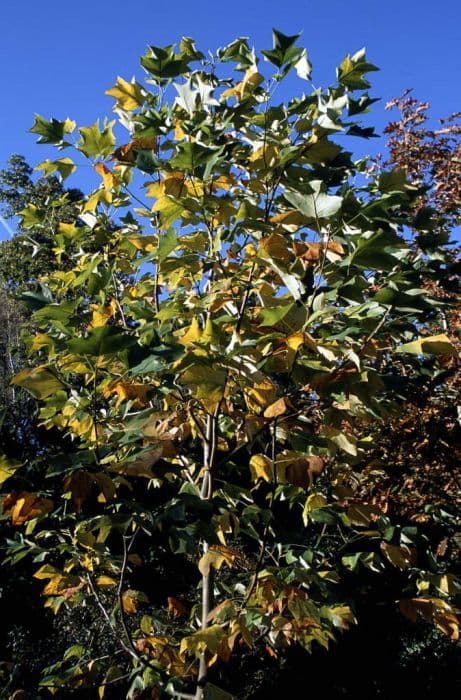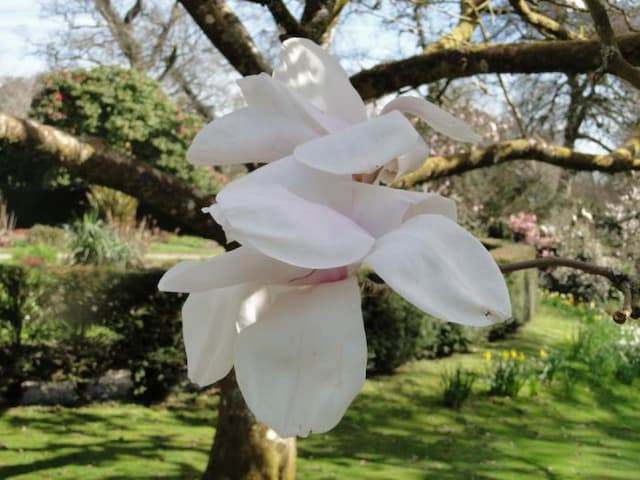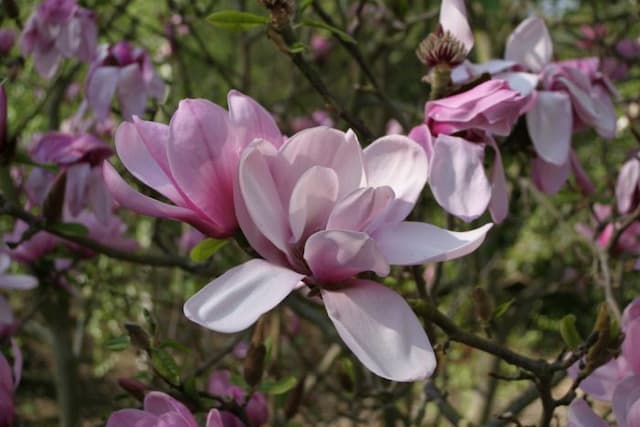Loebner Magnolia 'Ballerina' Magnolia × loebneri 'Ballerina'

ABOUT
The Loebner Magnolia 'Ballerina' is a captivating plant known for its spectacular floral display. It features large, star-shaped flowers that are predominantly white, often with a blush of pink. The petals are long, slender, and elegantly arranged in a way that resembles a ballerina's tutu, hence its name. The leaves are lush green, providing a striking backdrop to the blossoms. In the fall, the foliage may turn a golden brown, adding seasonal interest. The overall appearance of 'Ballerina' is graceful and elegant, making it a favorite in many gardens for its ornamental value.
About this plant
 Names
NamesFamily
Magnoliaceae
Synonyms
Loebner Magnolia, Ballerina Magnolia
Common names
Magnolia × loebneri 'Ballerina'
 Toxicity
ToxicityTo humans
The Loebner Magnolia 'Ballerina' is not known to be toxic to humans. It is generally considered safe and does not pose any significant health risks when handled or in proximity. However, as with any plant, it is always advisable to exercise caution and avoid ingestion, as individual reactions can vary.
To pets
The Loebner Magnolia 'Ballerina' is also not known to be toxic to pets. It is generally safe for animals, and there are no known toxic effects reported in pets such as dogs and cats. Nonetheless, it is recommended to prevent pets from chewing on any part of the plant as a precautionary measure, and to avoid potential gastrointestinal upset.
 Characteristics
CharacteristicsLife cycle
Perennials
Foliage type
Deciduous
Color of leaves
Green
Flower color
White
Height
10 feet 25 inches (3 meters)
Spread
10 feet 25 inches (3 meters)
Plant type
Tree
Hardiness zones
3
Native area
Asia
Benefits
 General Benefits
General Benefits- Aesthetic Appeal - The Loebner Magnolia 'Ballerina' adds beauty to landscapes with its large, star-shaped white flowers and lush green foliage.
- Wildlife Attraction - The blossoms attract pollinators such as bees and butterflies, supporting local ecosystems.
- Shade Provider - As a medium-sized tree, it offers shade in gardens and parks, enhancing outdoor comfort.
- Seasonal Interest - It provides year-round visual interest, with flowers in spring and vibrant leaf colors in autumn.
- Privacy Screen - When planted in groups, it can act as a natural privacy screen while enhancing the aesthetic of the area.
- Sound Barrier - The dense foliage can help dampen noise, making it ideal for planting in urban or suburban areas.
 Medical Properties
Medical PropertiesThis plant is not used for medical purposes
 Air-purifying Qualities
Air-purifying QualitiesThis plant is not specifically known for air purifying qualities.
 Other Uses
Other Uses- Landscape Focal Point - The Loebner Magnolia 'Ballerina' serves as a stunning focal point in landscape designs due to its striking blooms.
- Cut Flowers - Its beautiful flowers can be used in cut flower arrangements, adding elegance to indoor settings.
- Photography Backdrop - The tree, especially when in bloom, provides a picturesque backdrop for photography.
- Shade Gardening - Under its canopy, it creates a suitable environment for shade-loving understory plants.
- Educational Tool - It can be used in educational settings to teach about plant biology and hybridization.
- Habitat Creation - It offers a habitat for birds, providing nesting sites and shelter.
- Seasonal Decorating - Its branches and flowers can be used for decorative purposes during spring celebrations.
- Urban Greening - Suitable for urban planting, it contributes to green spaces in city environments.
- Windbreak - When planted in rows, it can act as a windbreak, protecting smaller plants.
- Seasonal Interest - It offers seasonal interest in gardens with its changing foliage and flowering patterns.
Interesting Facts
 Feng Shui
Feng ShuiThe Loebner Magnolia 'Ballerina' is not used in Feng Shui practice.
 Zodiac Sign Compitability
Zodiac Sign CompitabilityThe Loebner Magnolia 'Ballerina' is not used in astrology practice.
 Plant Symbolism
Plant Symbolism- Purity and Nobility - The pristine white flowers of the Loebner Magnolia 'Ballerina' symbolize purity and nobility, reflecting a sense of dignity and grace.
- Perseverance - The plant's ability to bloom early in spring, often while still cold, represents perseverance and resilience in the face of challenges.
- Renewal and New Beginnings - Its spring blooming signifies renewal and the start of new beginnings, making it a symbol of hope and rebirth.
 Water
WaterThe Loebner Magnolia 'Ballerina' should be watered deeply and thoroughly, ensuring the soil is moist but not waterlogged. During the growing season, water once a week with about 1-2 gallons per plant, depending on the weather conditions and soil moisture. It's important to reduce the frequency of watering during the dormant winter months. Over-watering can lead to root rot, so allow the soil to dry out slightly between waterings. The use of mulch can help retain soil moisture and reduce the need for frequent watering.
 Light
LightThe Loebner Magnolia 'Ballerina' performs best in full sun to partial shade. It should receive at least 4-6 hours of direct sunlight daily for optimal flowering. In hotter climates, providing some afternoon shade can protect the plant from excessive heat. An ideal spot would be one where the plant gets morning sunlight and some shelter from the intense afternoon sun.
 Temperature
TemperatureThe Loebner Magnolia 'Ballerina' is hardy and can withstand a range of temperatures. It prefers a temperature range between 35°F and 85°F. It can survive short periods of colder temperatures, as low as 20°F, but prolonged exposure to extreme cold or heat can be detrimental. The ideal conditions are moderate temperatures with protection from harsh winter winds and extreme summer heat.
 Pruning
PruningPrune the Loebner Magnolia 'Ballerina' to maintain shape and remove any dead or damaged branches. The best time for pruning is after the flowering season ends in late spring or early summer. This allows the plant to heal and minimizes the risk of infection. Pruning should be done sparingly, as this plant does not require heavy pruning.
 Cleaning
CleaningAs needed
 Soil
SoilThe Loebner Magnolia 'Ballerina' thrives in well-drained, rich soil with a pH of 5.5 to 6.5. A mix of loamy soil, compost, and peat moss is ideal for providing the necessary nutrients and drainage. The soil should be kept moist but not waterlogged to prevent root rot. Amending the soil with organic matter annually can help maintain its fertility and structure.
 Repotting
RepottingAs a tree, the Loebner Magnolia 'Ballerina' is typically not repotted. Instead, it is planted directly in the ground. If grown in a container, repotting may be necessary every 3-5 years, depending on the growth rate and size of the container. Spring is the best time for repotting to allow the plant to establish in its new container during the growing season.
 Humidity & Misting
Humidity & MistingThe Loebner Magnolia 'Ballerina' is adaptable to a wide range of humidity levels. It does well in average outdoor humidity conditions and does not require specific humidity adjustments. However, it is important to ensure good air circulation to prevent fungal diseases.
 Suitable locations
Suitable locationsIndoor
Place in bright, indirect light, ensure good air circulation, water regularly but don't overwater.
Outdoor
Plant in well-draining soil, full sun to partial shade, water deeply and regularly.
Hardiness zone
5-9 USDA
 Life cycle
Life cycleThe Loebner Magnolia 'Ballerina' starts its life as a seed, which germinates to form a seedling with initial leaves and a primary root. As it grows, it develops a sturdy stem and a robust root system, along with its characteristic green leaves. The plant enters a juvenile phase where it increases in size but does not flower. After several years, it reaches maturity and begins its blooming phase, typically in early spring, producing large, fragrant white flowers. After flowering, it focuses on leaf growth and strengthening its structure. Each year, the cycle of blooming and growth repeats, with the tree becoming more established and potentially larger with each passing season.
 Propogation
PropogationPropogation time
Early spring
The most popular method of propagating the Loebner Magnolia 'Ballerina' is through softwood cuttings. This is ideally done in early spring when new growth is soft and green. Cuttings should be about 4-6 inches long and include at least two sets of leaves. Remove the lower leaves and dip the cut end in rooting hormone to encourage root development. Plant the cuttings in a mixture of peat and perlite, ensuring the soil is kept moist but not waterlogged. Cover the cuttings with a plastic bag or place them in a greenhouse to maintain high humidity. Roots typically develop within 4-6 weeks, after which the new plants can be gradually acclimatized to outdoor conditions before transplanting into the garden.
 Pests
PestsScale insects, Aphid, Japanese beetle
 Diseases
DiseasesVerticillium wilt, Powdery mildew, Leaf spot









![Magnolia [Felix Jury]](/_next/image?url=https%3A%2F%2Fplants-admin.emdemapps.com%2Fimages%2Fplants%2F%2Fimages%2F604b61a0b23b7.png&w=640&q=75)